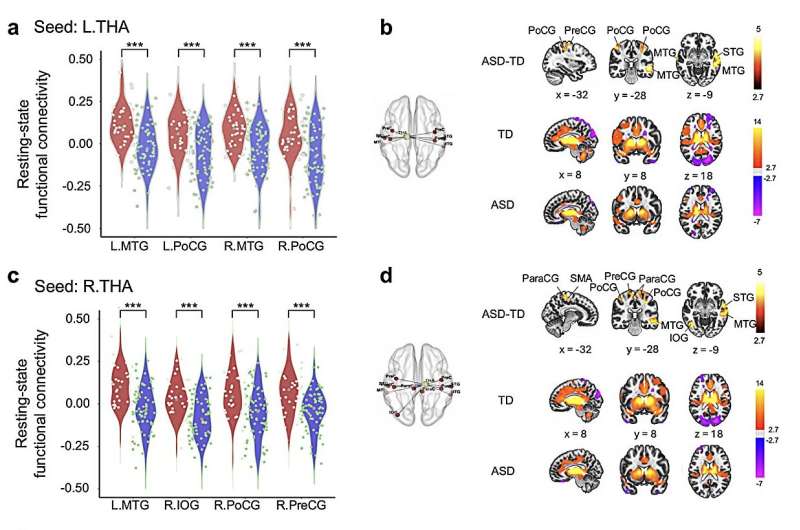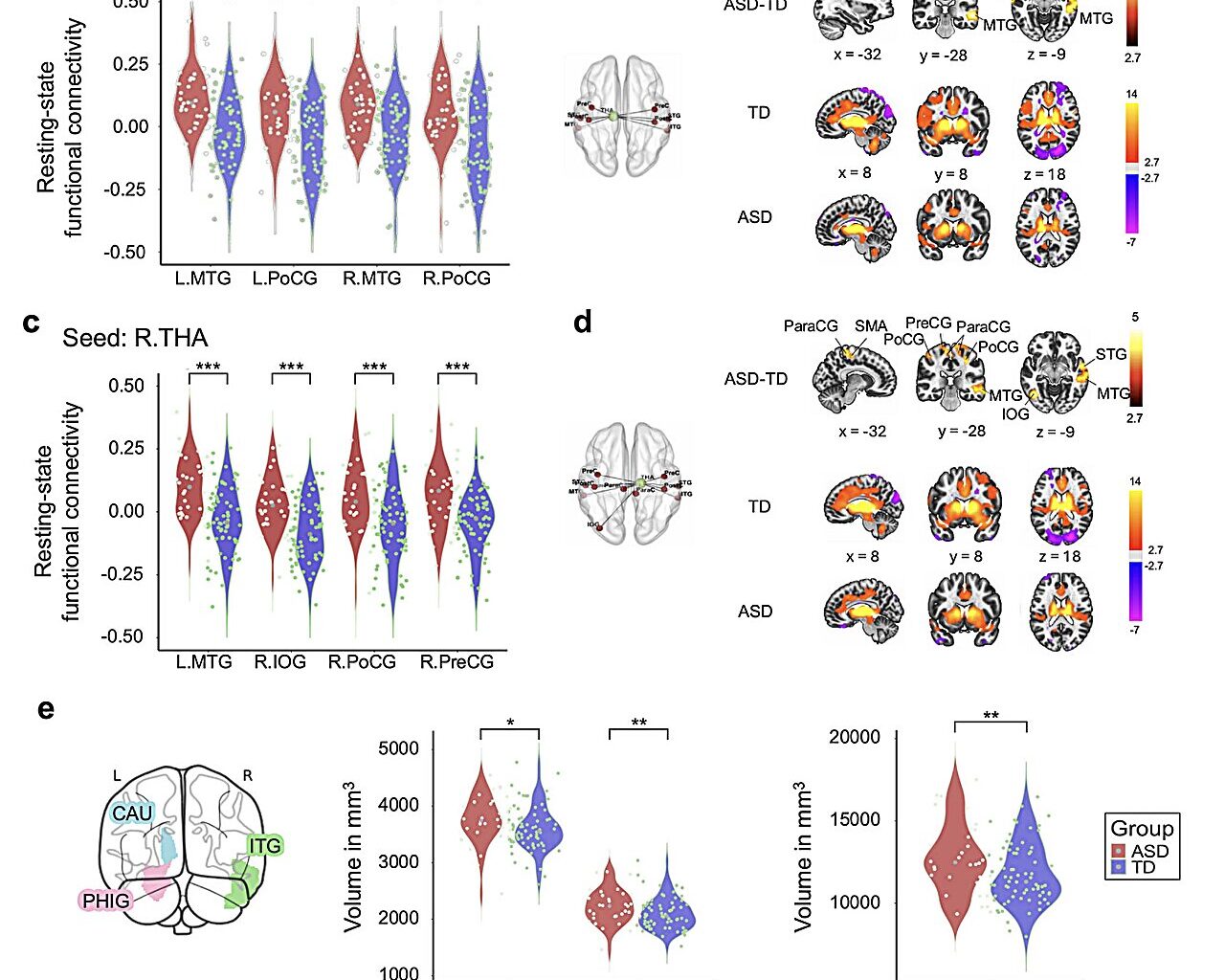
Differences in brain features between ASD and TD groups. Credit: Translational Psychiatry (2025). DOI: 10.1038/s41398-025-03566-2
Autism spectrum disorder (ASD) is a neurodevelopmental disorder that is estimated to be experienced by roughly 1 in 127 people worldwide. It is characterized by atypical patterns in brain development, which manifest in differences in communication, social interactions, behavior and responses to sensory information.
Past neuroscientific and genetic studies suggest that a variety of factors contribute to the development of ASD. These can include genetic factors, chemical alterations that influence the expressions of genes (i.e., epigenetic factors), differences in the structure of specific brain regions or neural circuits, and environmental factors, such as early life events or infections or immune responses during pregnancy.
Researchers at the Korea Brain Research Institute and University of Fukui in Japan recently carried out a study aimed at further exploring these different dimensions of ASD, focusing on brain structure, the communication between brain regions, epigenetic changes and behavioral patterns. Their findings, published in Translational Psychiatry, paint a clearer picture of the intricate underpinnings of the disorder and could inform the development of more precise tools for diagnosing it.
“ASD, a disorder with heterogeneous etiology, is characterized by abnormal behavioral responses to sensory inputs,” wrote Yongjeon Cheong, Jihyun Bae and their colleagues wrote in their paper. “However, there is still limited understanding of how brain and epigenetic factors, along with behavioral abnormality, contribute to ASD.”
To further explore the role of brain differences, epigenetic factors and behavioral tendencies in ASD, Cheong, Bae and their colleagues carried out an experiment involving 34 people diagnosed with the disorder and 72 people who were not. The study participants were all asked to complete a well-known questionnaire designed to assess how people respond to sensory experiences, known as the Adolescent-Adult Sensory Profile.
“After completing Adolescent-Adult Sensory Profile, a self-report questionnaire, 34 individuals with ASD and 72 controls underwent neuroimaging scans to measure brain structural (cortical and subcortical volume) and functional (thalamo-cortical resting-state functional connectivity) characteristics,” wrote the researchers. “For epigenetic measures, we computed DNA methylation values of the oxytocin receptor and arginine vasopressin receptor (AVPR) genes from the participants’ saliva.”
In addition to asking participants to complete the Adolescent-Adult Sensory Profile questionnaire, the researchers used brain imaging techniques to measure the volume of different regions in their brains and to map out connections between these regions at rest (i.e., their functional connectivity). They also collected saliva samples, which they then analyzed to detect epigenetic modifications (i.e., chemical changes that influence the expression of genes).
Cheong, Bae and their colleagues ultimately analyzed all the data they collected using a machine learning model, to map the contribution of brain-related, epigenetic and behavioral factors to the disorder. Notably, they found that a model integrating all of these factors was better at predicting the diagnosis of ASD than models that focused on individual dimensions.
“When sensory-related behavior was the default baseline, a machine learning algorithm demonstrated that the neuroimaging-epigenetic model outperformed the neuroimaging model or the epigenetic model,” wrote the authors.
“Thalamo-cortical hyperconnectivity and AVPR 1A epigenetic modification were found to be significant contributing factors in these models. By integrating neuroimaging and epigenetic biomarkers with behaviors, a more precise diagnosis of ASD can be achieved.”
The recent work by Cheong Bae and their colleagues could soon open new possibilities for the development of multi-dimensional machine learning-based tools designed to aid health care professionals in the diagnosis of ASD. In the future, other research groups might build on this study to investigate the interactions between the various factors contributing to ASD or to create new biomarker-based diagnostic strategies.
Written for you by our author Ingrid Fadelli, edited by Lisa Lock, and fact-checked and reviewed by Robert Egan—this article is the result of careful human work. We rely on readers like you to keep independent science journalism alive.
If this reporting matters to you,
please consider a donation (especially monthly).
You’ll get an ad-free account as a thank-you.
More information:
Yongjeon Cheong et al, Dissecting the heterogeneity of autism spectrum disorder with sensory behavior, brain, and epigenetic factors, Translational Psychiatry (2025). DOI: 10.1038/s41398-025-03566-2
© 2025 Science X Network
Citation:
Experiment explores contribution of neural, epigenetic and behavioral factors to autism spectrum disorder (2025, October 1)
retrieved 2 October 2025
from https://medicalxpress.com/news/2025-10-explores-contribution-neural-epigenetic-behavioral.html
This document is subject to copyright. Apart from any fair dealing for the purpose of private study or research, no
part may be reproduced without the written permission. The content is provided for information purposes only.

